
This Is How Safe The Hyundai Venue Is In Australia
- Dec 20, 2019
- Views : 7742

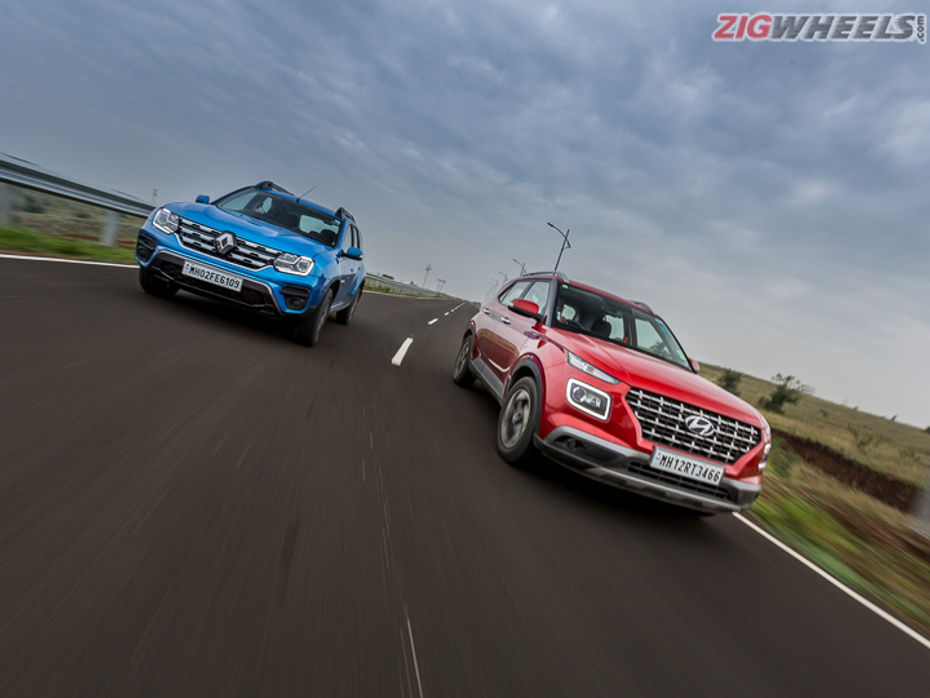
It’s very rare that the bigger car in a comparison review is lighter on the pocket. In the case of the Duster CVT, Renault is tempting us with a price tag that asks serious questions of sub-compact SUVs. For similar money, you could also pick Hyundai's Venue DCT. A contender that’s loaded enough for you to ponder if that slightly bigger SUV is worth considering at all.
The Value Equation
Renault’s Duster is priced at Rs 9.99 lakh and is available in a single variant: the RXS (O). The Venue on the other hand, is available in two variants — the S and SX+ — priced at Rs 9.35 lakh and Rs 11.10 lakh respectively. For this comparison, we’ve picked the more expensive version of the Hyundai sub-compact SUV.
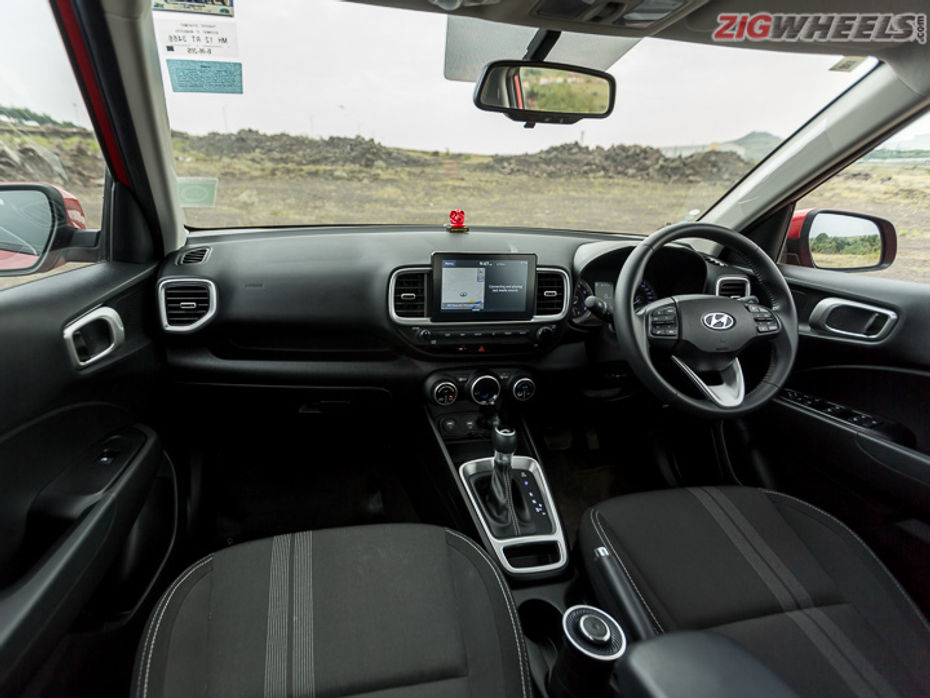
In our books, the SX+ variant easily justifies its ~ Rs 1.1 lakh extra asking price over the Duster. It’s stuffed to the grille with features, making you feel like you’ve bought the more premium car. You can access the car with the key tucked in your pocket and even start it up using a button. In fact, you don’t need to be near the car to do that — you can do it using an app Hyundai likes to call BlueLink. There are loads of feel-good elements too, including automatic climate control, cruise control, leather-wrapped steering, and the all-important sunroof. Plus, it also has a bigger touchscreen (that’s aeons ahead in terms of user-friendliness and responsiveness) and a sweeter 6-speaker music system.
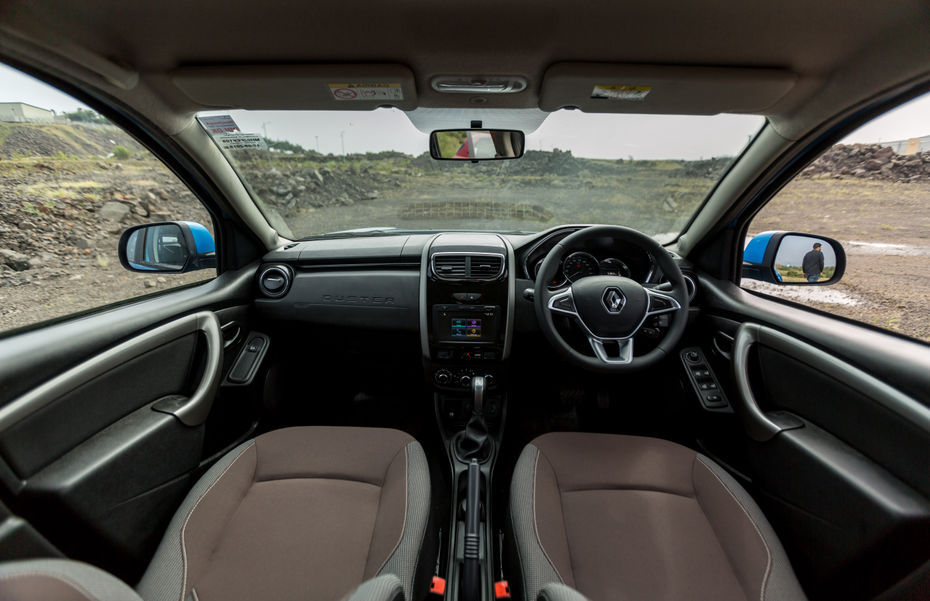
With the Duster, you get one feature that the Venue won’t offer: a central armrest for the rear occupants. The feature list is quite barebones on the Renault, missing out on basics like front fog lamps, height-adjustable driver’s seat, reverse parking camera and speed-sensitive door locks. The only highlights come in the form of daytime running lamps, 16-inch alloy wheels and a touchscreen infotainment system. Plus, the interior quality is nothing to write home about either; the Venue feels richer for sure.
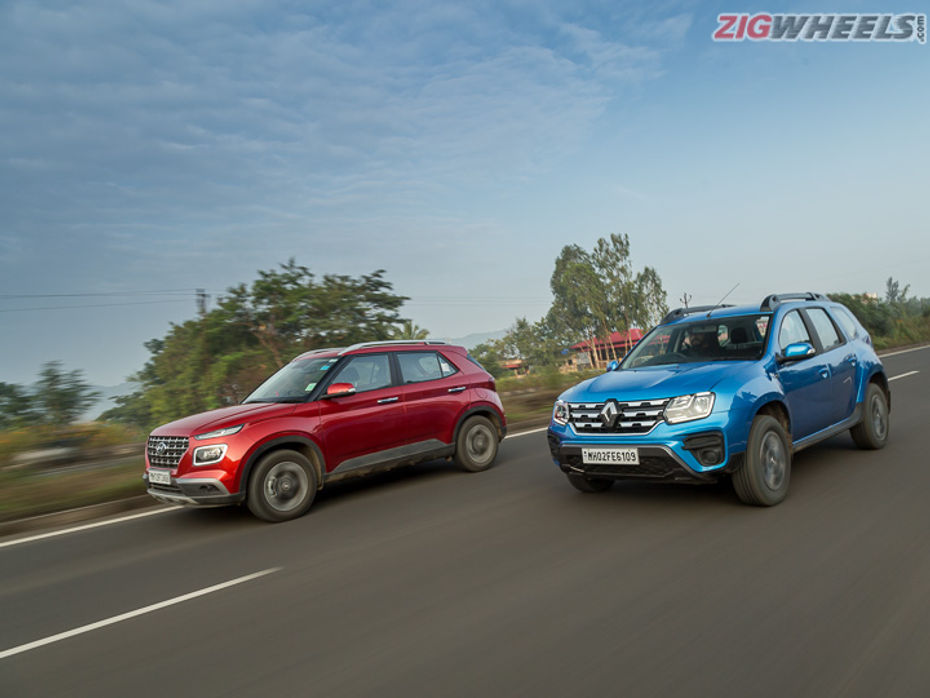
Both offer the same set of basic safety features — dual airbags, ABS with EBD and reverse parking sensors. There’s electronic stability program and hill assist on offer as well. Additionally, the Venue offers a parking camera, projector fog lamps and cornering lamps.
Size On Its Side?
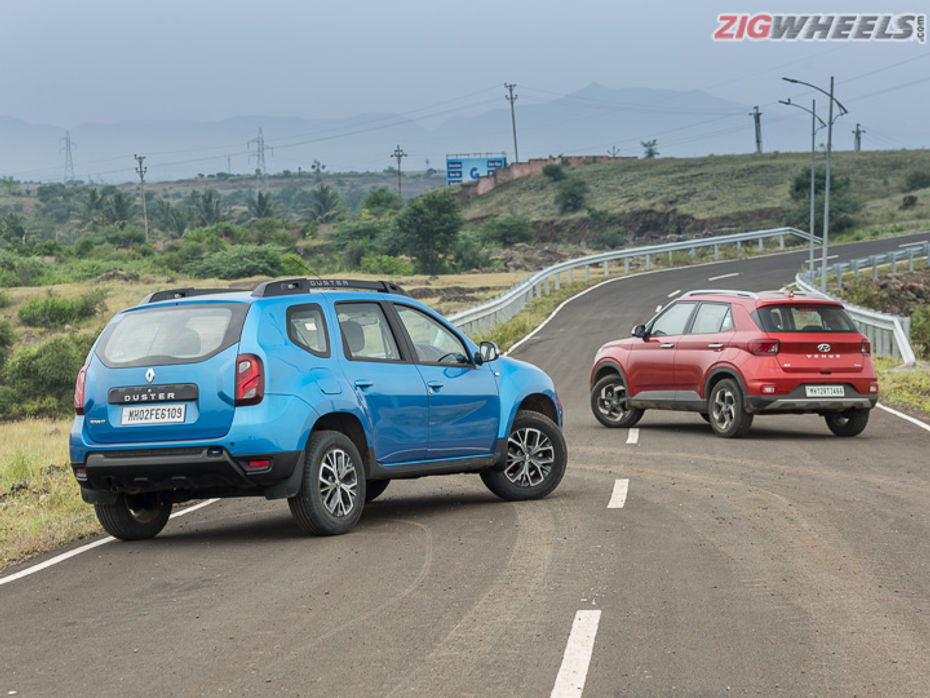
The Duster appeals with its old-school macho SUV looks. Park one next to the Venue and it makes the Hyundai look like a tiny hatchback. Not really surprising considering the gulf in dimensions. It’s 365mm longer, 52mm wider and 105mm taller. The wheelbase, too, is a whopping 173mm longer on the Duster. This should mean that Renault’s trump card is space, correct?
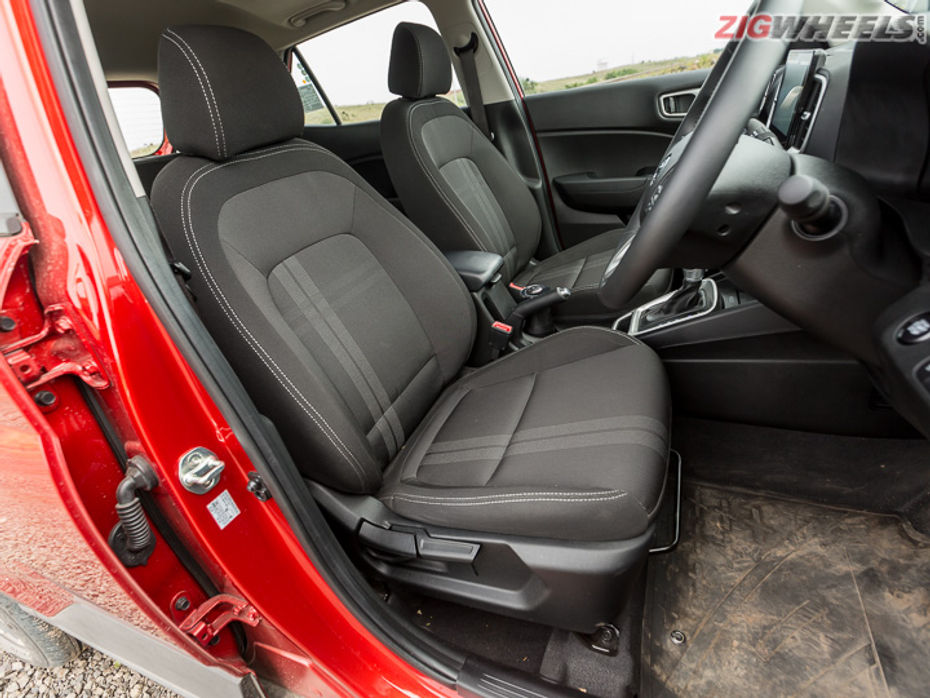
Wrong! It’s the Venue that offers a more comfortable front seat experience. Kneeroom is marginally better in the Hyundai and the deficit in cabin width is negligible. The Duster’s ergonomics cancel out any advantage that it has in terms of size. For instance, your right knee will brush against the door pad while your left will do the same against the centre console. The pedal box feels cramped too, and neither do you have an armrest at the front. You’d have none of these issues in the Venue.
|
Venue |
Duster |
|
|
Interior Measurements (Front) |
||
|
Legroom |
910-1070mm |
940-1080mm |
|
Kneeroom |
570-780mm |
570-755mm |
|
Seat base length |
480mm |
500mm |
|
Seat base width |
470mm |
510mm |
|
Seat back height |
610mm |
555mm |
|
Headroom (min-max) |
965-885mm |
950mm |
|
Cabin width |
1370mm |
1380mm |
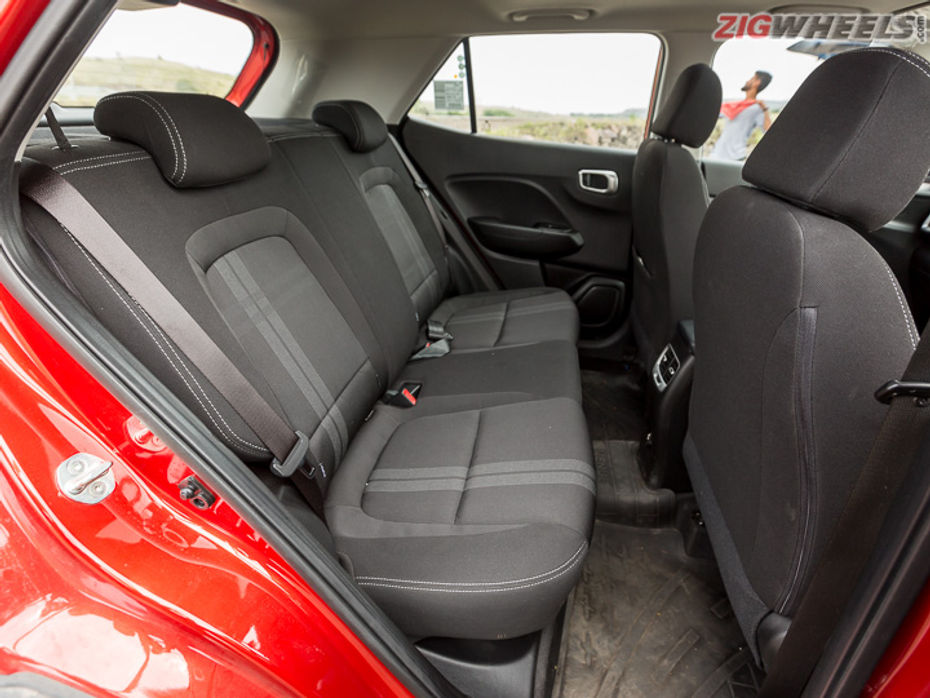
Yes, the Duster does offer noticeably better kneeroom for rear seat occupants. But it’s unlikely to feel like a huge step up over the Venue. However, the additional width comes into play, and you can seat three occupants in relative comfort here, compared to the Hyundai. Sadly, the seat is mounted high up, which means headroom isn’t as good as the Venue’s. Yes, the Hyundai is far from spacious. But it’s got ample room for four adults and a kid.
|
Venue |
Duster |
|
|
Interior Measurements (Rear) |
||
|
Shoulder Room |
1290mm |
1310mm |
|
Headroom |
970mm |
950mm |
|
Kneeroom |
575-785mm |
605-810mm |
|
Seat Base Width |
1235mm |
1379mm |
|
Seat Base Length |
450mm |
465mm |
|
Seat Back Height |
655mm |
600mm |
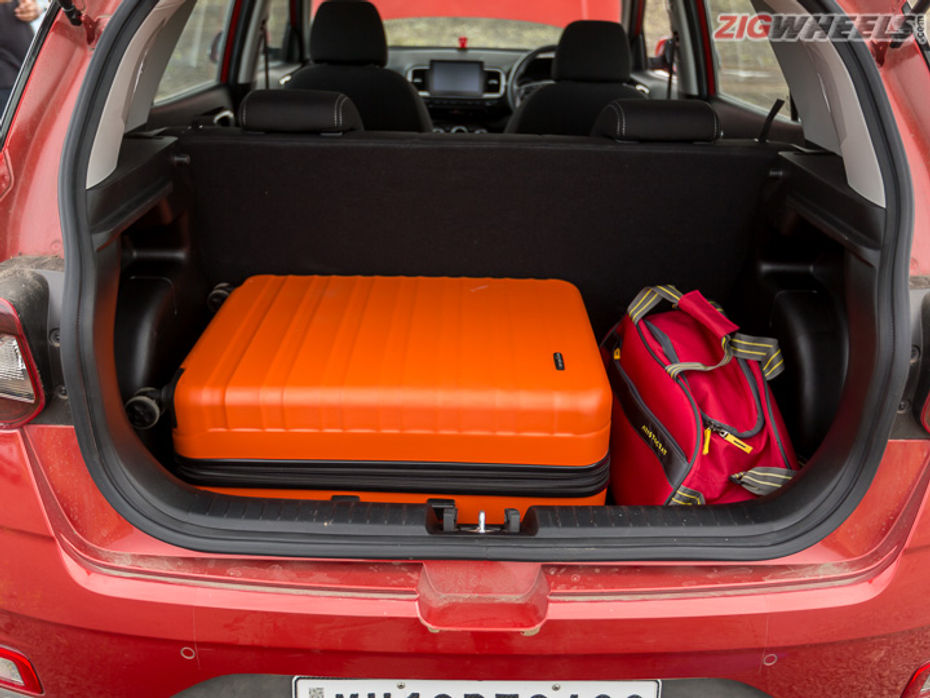
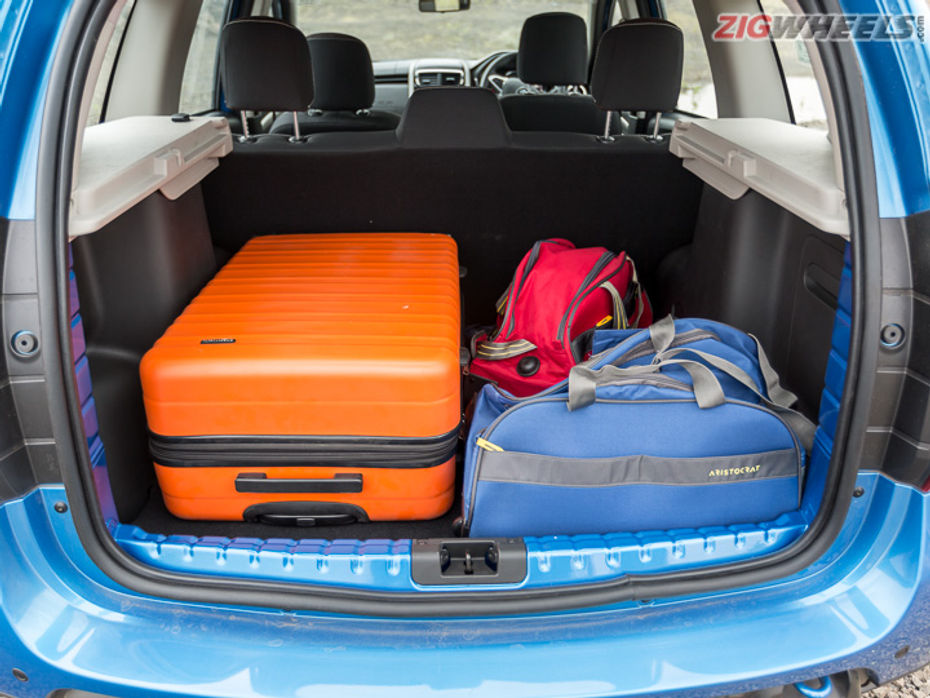
The 350-litre boot on the Venue is shaped well, and will have no issues taking up a large suitcase and a couple of duffle bags easily. The Duster one-ups the Venue quite easily in this department, with 475 litres of boot volume. That’s more than enough for two large suitcases, or one large suitcase and a couple of duffel bags.
Drive Easy!
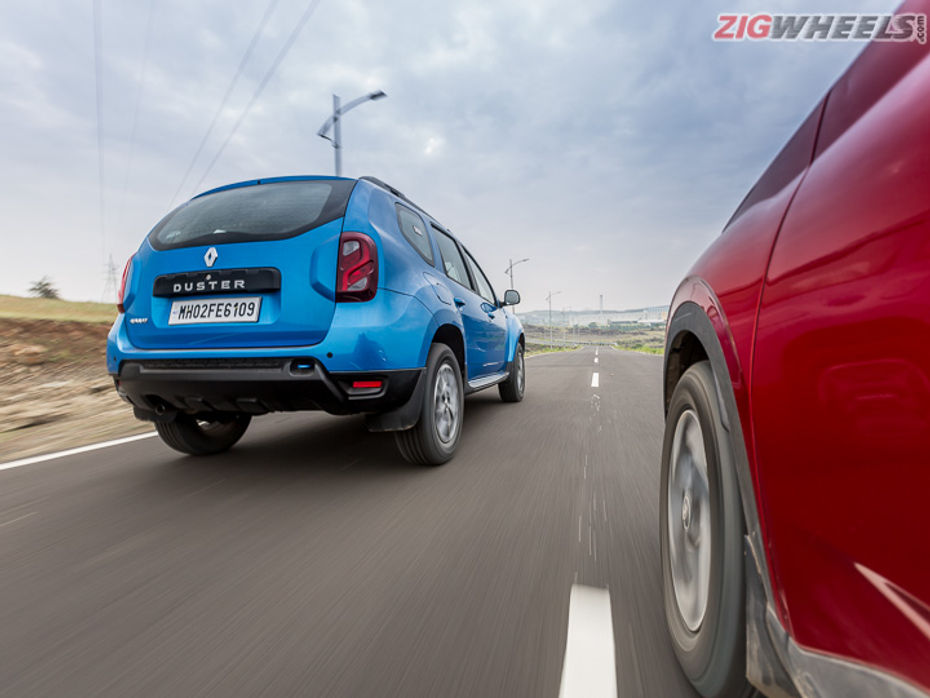
That’s the promise both claim to deliver on. On paper, the specs are poles apart. The Duster uses an old-school four-cylinder, naturally aspirated engine that makes a healthy 106PS and 142Nm. On the other hand, the Venue has a turbocharged three-cylinder motor that’s dishing out 120PS and 172Nm. Between the two, it’s the Renault’s 1.5-litre motor that’s smoother. The Hyundai’s motor feels slightly clattery at idle but it’s acceptable on the move.
|
Specs |
Venue DCT |
Duster CVT |
|
Engine |
1.0 litre, 3 cylinder |
1.5 litre, 4 cylinder |
|
Power |
120PS @ 6000rpm |
106PS @ 5600rpm |
|
Torque |
172Nm @ 1500-4000rpm |
142Nm @ 4000rpm |
|
Transmission |
7-speed DCT |
CVT |
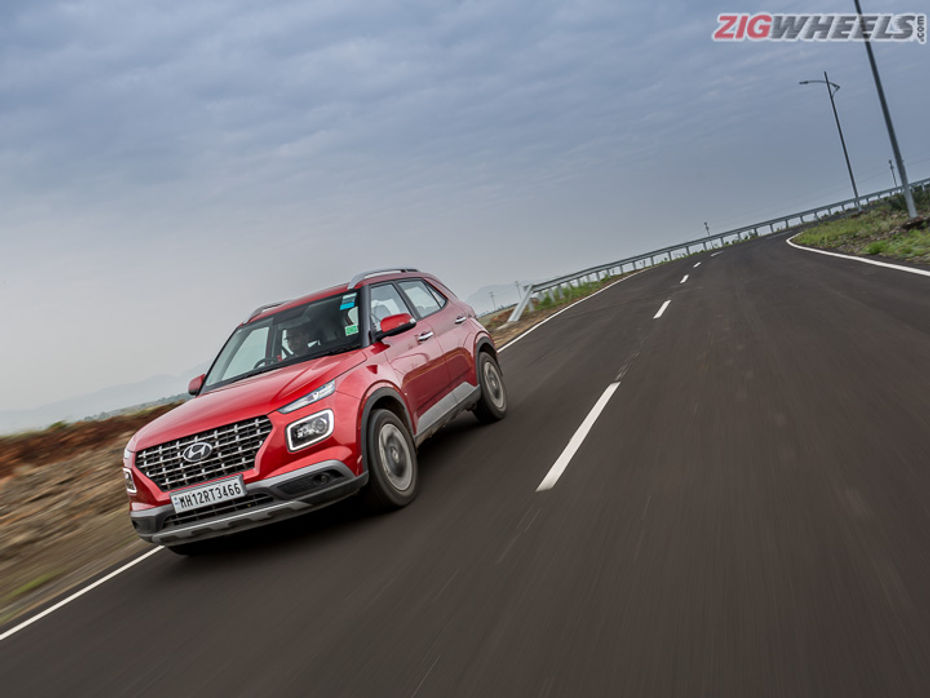
With more power and less weight, it’s no real surprise that the Venue will leave the Duster in the *ahem* dust. It’s a full 6 seconds quicker to 100kmph, and in-gear acceleration is a lot, lot stronger. With the Venue, you can pick gaps in traffic and on the highway with that much more ease. Sure, the dual-clutch transmission isn’t as quick as Volkswagen’s DSG. But that split second of lag isn’t going to bother you for an everyday SUV. It also feels more responsive and eager, picking up minor inputs on the throttle swiftly.
|
Venue DCT |
Duster CVT |
|
|
0-100kmph |
11.24 seconds |
17.15s |
|
20-80kmph (kickdown) |
6.72 seconds |
10.06s |
That’s not to say the Duster’s CVT feels slow and lazy. Inside the city, it will give you no reason to complain. It builds power gradually and never gives you that sudden surge. Even if you slam the throttle down, the acceleration is progressive. The CVT feels slightly lethargic for the ‘quick lane switch and overtake’ manoeuvre. But for a steady (read: relaxed) cruise at 80-120kmph, it does just fine.
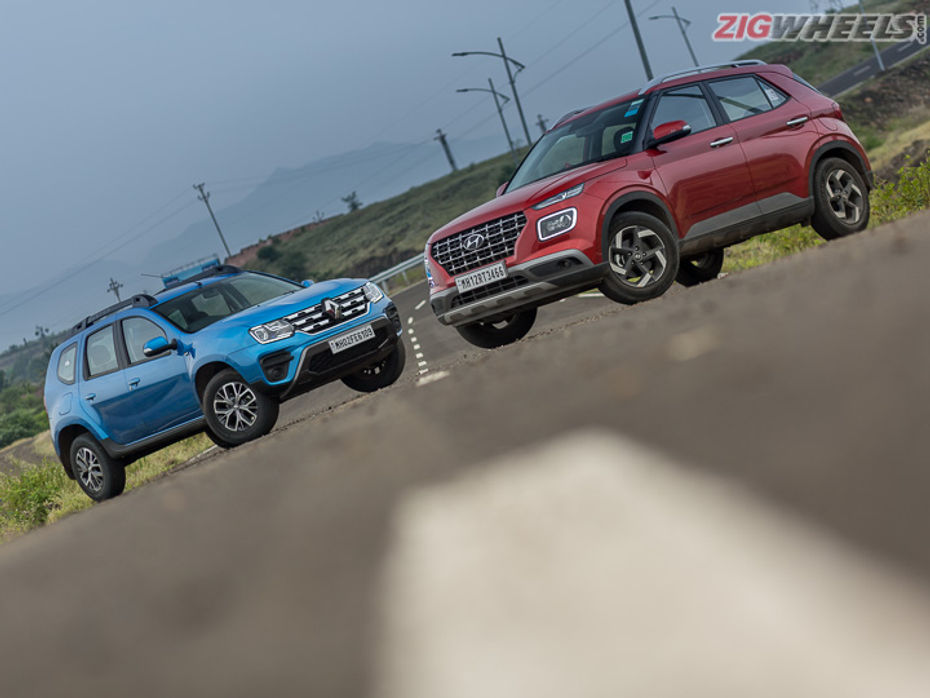
It’s the Venue again that’s at home weaving through thick city traffic. Much like the Duster, you can see the edge of the bonnet from the driver’s seat of the Hyundai. The smaller footprint and the feather-light steering make city drives fuss-free. In the Duster, you tend to worry about the flared fenders and the heavy steering doesn’t make things easier either.
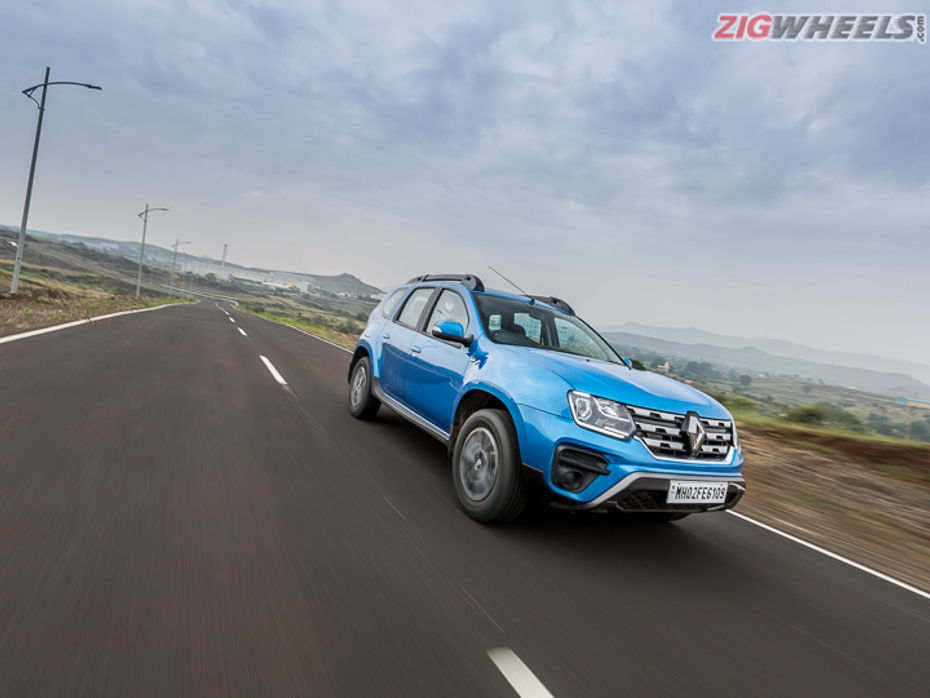
Surprisingly, it’s the bigger, heavier car that’s more frugal inside the city. We managed to eke out an extra 1.43kmpl from the Duster. Expectedly, the Venue edged ahead on the highway mileage run, delivering an additional 2.18kmpl.
|
Venue DCT |
Duster CVT |
|
|
City Fuel Efficiency |
10.25kmpl |
11.68kmpl |
|
Highway Fuel Efficiency |
16.72kmpl |
14.54kmpl |
In terms of ride comfort, the Duster simply pummels the Venue. The way it tackles bumps, potholes and broken roads has to be experienced to be believed. Irrespective of speed or surface, the Duster ensures that the passengers aren’t tossed around. And it does all of this quietly! With the Venue, you’d notice some side-to-side rocking, especially over sharper bumps. That said, both cars feel adequately stable at highway speeds and inspire confidence in the driver.
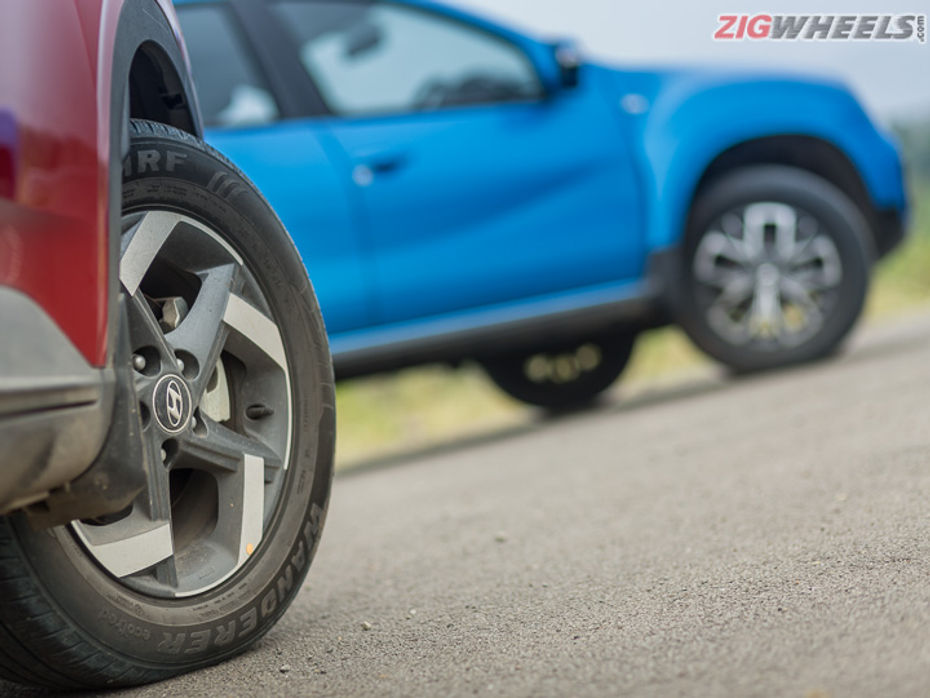
Should you want to go hunting corners, it’s the Venue that’s got the naughty side. With a sharper steering, a tighter wheelbase and a punchy motor, you can have some fun. The Duster’s steering kicks back violently if you push it too hard, and you’ll feel it roll too. It never gets unnerving, though.
David vs Goliath?
Surprisingly, it isn’t as tricky to figure out which one you’d rather pick. Just answer a question: what would you rather have? An SUV that’s physically larger on the outside, or one that pampers you silly for the money you've paid?

For us, it has to be the latter. Simply because the bigger car doesn’t bring enough to the table. The Duster has a smooth engine, an easygoing gearbox and epic ride quality on its side. But the iffy ergonomics and the barebones feature list do sour the overall experience. Had Renault offered a top-spec Duster CVT with a few more bells and whistles, it’d have made a stronger case.
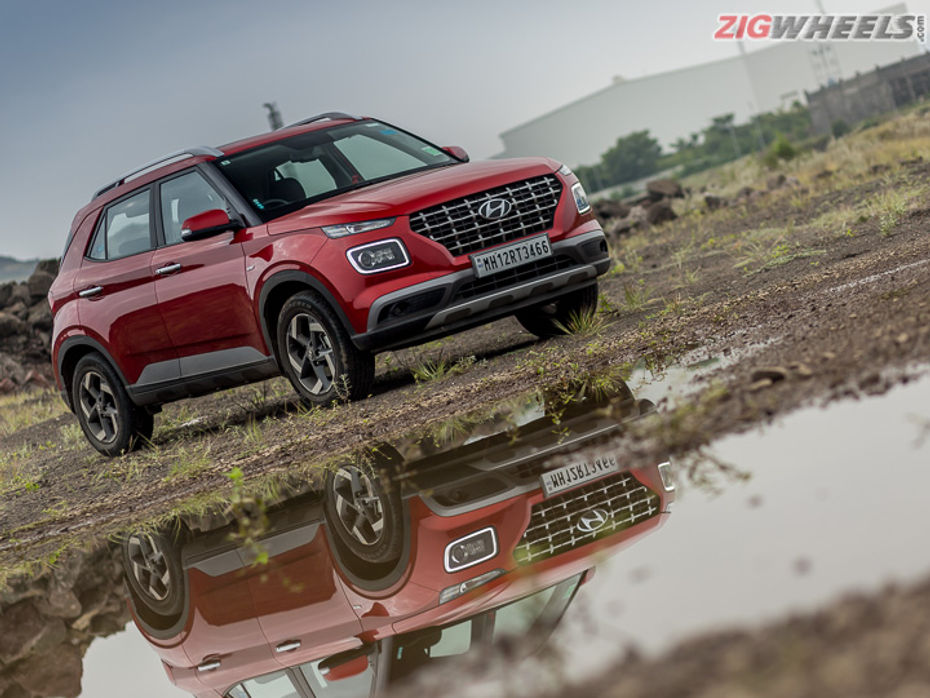
We’d say that for the Venue too. Although Hyundai has made up for quite a lot with the SX ‘+’ trim, misses like a rear wiper and side and curtain airbags seem unnecessary. You’d also have to compromise on cabin and boot space (not by much though). But the positives far outweigh the negatives here. The balance of fun and frugality, versatile automatic gearbox and extra servings of feel-good features tilt the scales heavily in the Venue’s favour.

This Is How Safe The Hyundai Venue Is In Australia

Chasing Wild Cats: Great India Drive ft. Hyundai Venue: A Photologue

2020 Hyundai Venue BS6 vs Rivals: Diesel Engine Specifications...

Hyundai Venue DCT vs Renault Duster CVT: The Stress Test!

Hyundai Venue vs Mahindra XUV300 vs Ford EcoSport: Comparison

Venue vs XUV300 vs EcoSport: Diesel SUV Comparison Review

Hyundai Venue vs Mahindra XUV3OO Comparison Review & Tested on road...

Hyundai Venue 2019 Launched & Price in India vs XUV300, Brezza

Hyundai Venue vs Rivals: Price, Engine, Size and Features Compared

Hyundai Venue Vs MG Hector - Connected Features Compared
India's largest automotive community